Improved Design of Fuse Tube for Environmental Protection Cabinet Based on Electric-Field Simulation
Abstract
:1. Introduction
2. Electric-Field Simulation with Fuse Tube
2.1. Static-Field Simulation Analysis Process
2.2. Theoretical Basis of Electric-Field
2.3. The Establishment of Simulation Model
2.4. Electric-Field Simulation and Result Analysis
- (1)
- Because the installation led to many air gaps in the plug, these air gaps and the surrounding conductors and silicone rubber formed a high potential, insulation and air three different media intersection, resulting in the concentration of the field in the plug, easily causing insulation breakdown.
- (2)
- The ring rod and other metals inside the fuse tube had high potential, and the ground rod had low potential. The potential passed through the air from a high potential to a low potential, and so, the air field around the ground rod and connecting rod was very strong.
3. Design of Improvement Scheme of Fuse Tube
3.1. Plug Part Improvement
3.1.1. Improvement of Air Gap between Plug and Alloy Cover
3.1.2. The Screw Inside the Plug Is Improved
3.2. Ground Rod Partial Improvement
3.2.1. Improvement of Grounding Connecting Rod
3.2.2. Ground Rod Front-End Air Zone Improvement
3.2.3. Ground Rod Rear-End Air Zone Improvement
4. Partial Discharge Test of Fuse Tube
5. Conclusions
- (1)
- Brush conductive paint on the silicone rubber surface adjacent to the alloy cover to form equipotentiality, so as to avoid the formation of a high potential, insulation, and air intersection, which results in a gas gap discharge.
- (2)
- Brush conductive paint on the silicone rubber wall around the slit of the screw in the plug, which forms the suspension potential, equipotentiality, and the uniform electric-field with the screw.
- (3)
- Add a ground shielding net to the fuse tube directly below the grounding connecting rod. The metal shielding structure adopts epoxy resin through integrated pouring so that the potential shield is inside the fuse tube. Then, add a small 4 mm high boss on the surface of the fuse tube above the shielding ring; the lower end of the epoxy shell grows to cover the fuse tube front boss, increasing the epoxy thickness to prevent breakdown.
- (4)
- Add a 40 mm × 133.5 mm earth shielding net inside the fuse tube that is 8 mm away from the surface of the high-potential ring rod, and shield the electric-field inside the epoxy.
- (5)
- Add a 42.5 mm-long and 17 mm-radius ground shielding ring at the end of the grounding rod to avoid electric-field concentration and insulation breakdown.
Author Contributions
Funding
Data Availability Statement
Conflicts of Interest
References
- Wegierek, P.; Kostyla, D.; Lech, M. Directions of Development of Diagnostic Methods of Vacuum Medium-Voltage Switchgear. Energies 2023, 16, 2087. [Google Scholar] [CrossRef]
- Zhang, T.; Zhou, W.; Yu, J.; Yu, Z. Insulation properties of C4F7N/CO2 mixtures under lightning impulse. IEEE Trans. Dielectr. Electr. Insul. 2020, 27, 181–188. [Google Scholar] [CrossRef]
- Li, Y.; Wang, Y.; Xiao, S.; Li, Z.; Tang, N.; Zhou, Y.; Li, L.; Zhang, Y.; Tang, J.; Zhang, X. Partial discharge induced decomposition and by-products generation properties of HFO-1234ze(E)/CO2: A new eco-friendly gas insulating medium. J. Phys. D Appl. Phys. 2023, 56, 165203. [Google Scholar] [CrossRef]
- Sun, T.; Li, L.; Li, G.; Yang, S.; Wang, W. Evaluation and optimization of electric-field on a high-voltage switchgear in nuclear power station. Electr. Eng. 2021, 103, 2733–2746. [Google Scholar] [CrossRef]
- Ghasemzadeh, M.R.; Faghihi, F.; Mozafari, S. FEM analysis of elliptical void in insulator of GIS compartment based on electric-field distribution. Electr. Power Syst. Res. 2023, 220, 109261. [Google Scholar] [CrossRef]
- Li, X.; Zhang, G.; Cao, C.; Shi, Y.; Li, J.; Chang, W. Effects of volume and surface conductivity on the surface charge and electric-field characteristics of the tri-post insulator in SF6-filled +/− 500 kV DC-GIL. IET Gener. Transm. Distrib. 2023, 17, 230–239. [Google Scholar] [CrossRef]
- Zheng, Y.; Xiao, S.; You, Y.; Ma, Z.; Huang, S. Partial discharge of fuse tube based on electrostatic-field simulation. High Volt. Eng. 2018, 54, 157–164. [Google Scholar] [CrossRef]
- Vu-Cong, T.; Toigo, C.; Jacquier, F.; Girodet, A.; Tuczek, M.N.; Riechert, U.; Mor, A.R. Long-Term Partial Discharge Behavior of Protrusion Defect in HVDC GIS. IEEE Trans. Dielectr. Electr. Insul. 2023, 29, 2294–2302. [Google Scholar] [CrossRef]
- Li, S.; Song, P.; Wei, Z.; Li, X.; Tang, Q.; Meng, Z.; Li, J.; Liu, S.; Wang, Y.; Li, J. Partial Discharge Detection and Defect Location Method in GIS Cable Terminal. Energies 2023, 16, 413. [Google Scholar] [CrossRef]
- Yao, Y.; Ouyang, X.; Zeng, G.; Tang, Q.; Ma, W. Research on modularizing design of 10 kV switchgear with line outlet for live maintenance. Energy Rep. 2021, 7, 10–16. [Google Scholar] [CrossRef]
- Krajewski, W.; Krasuski, K.; Blazejczyk, T. Some aspects of medium voltage switchgear designing with aid of numerical analysis. IET Sci. Meas. Technol. 2020, 14, 651–664. [Google Scholar] [CrossRef]
- Geng, J.; Qin, Y.; Lv, F.; Yao, X.; Ding, Y. Electric Field Distribution and Switching Impulse Discharge under Shield Ball Surface Scratch Defect in an UHVDC Hall. Energies 2018, 11, 1408. [Google Scholar] [CrossRef] [Green Version]
- Carlos del-Pino-Lopez, J.; Hatlo, M.; Cruz-Romero, P.; Filho, S. On Simplified 3D Finite Element Simulations of Three-Core Armored Power Cables. Energies 2018, 11, 3081. [Google Scholar] [CrossRef] [Green Version]
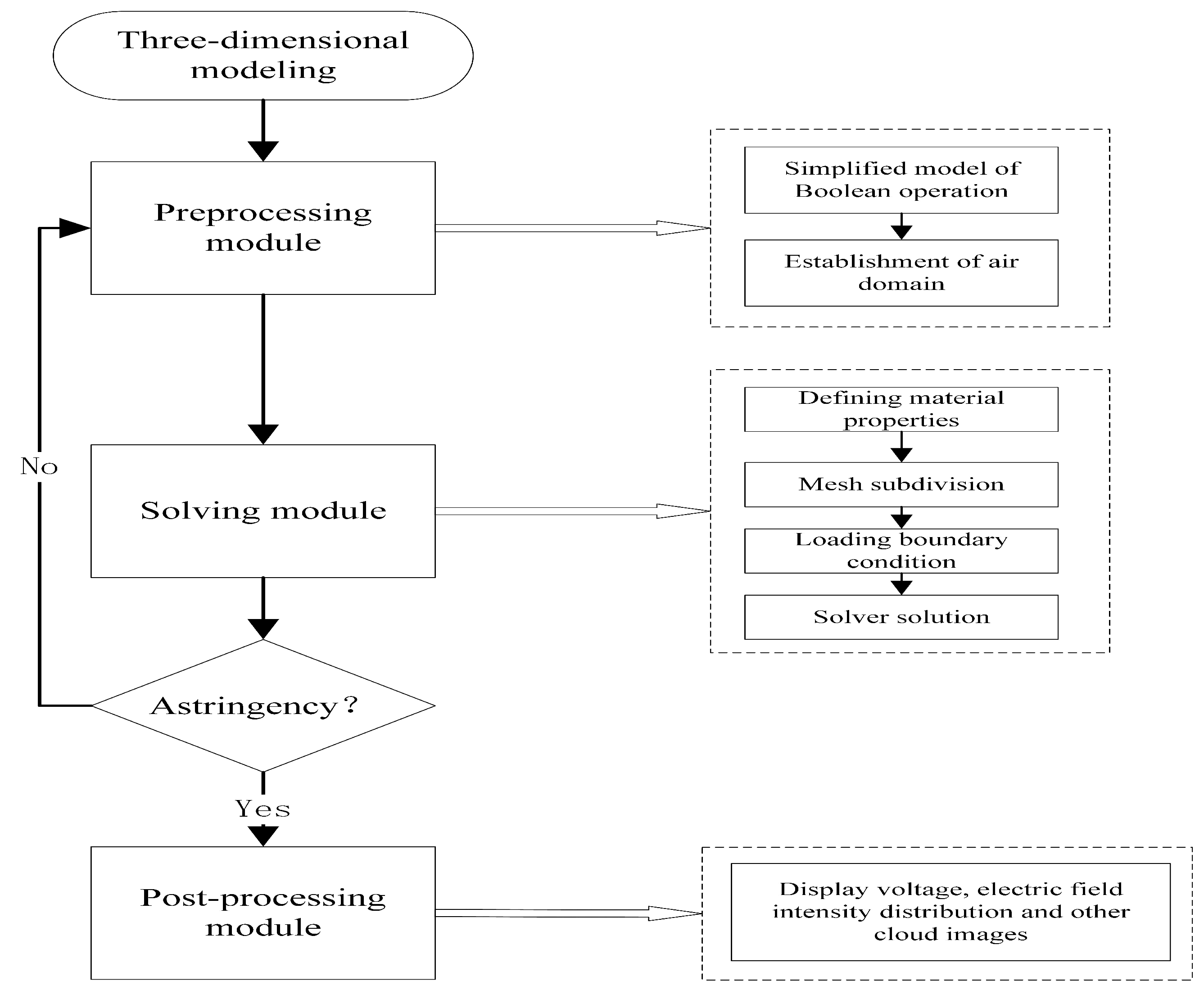
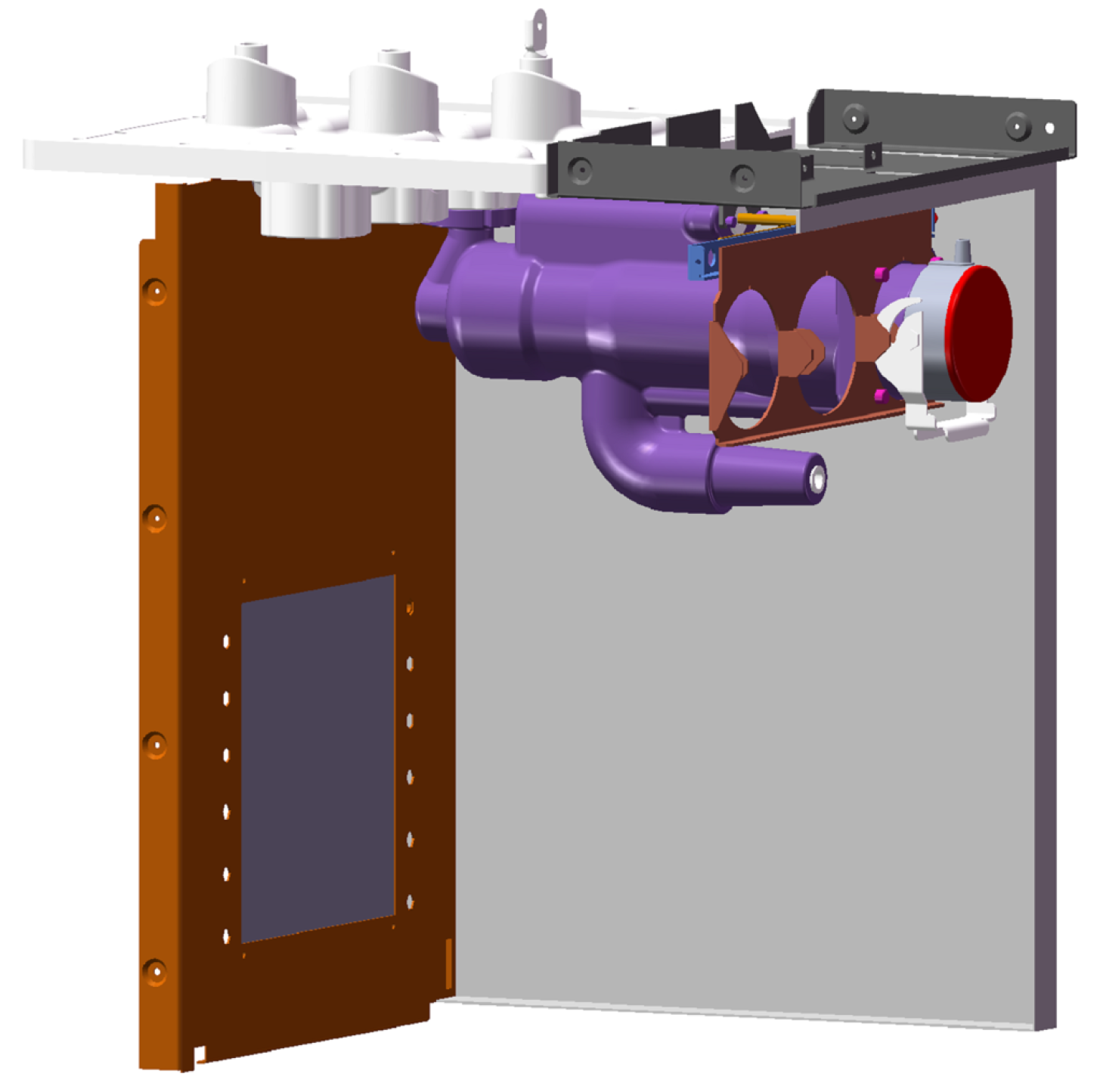
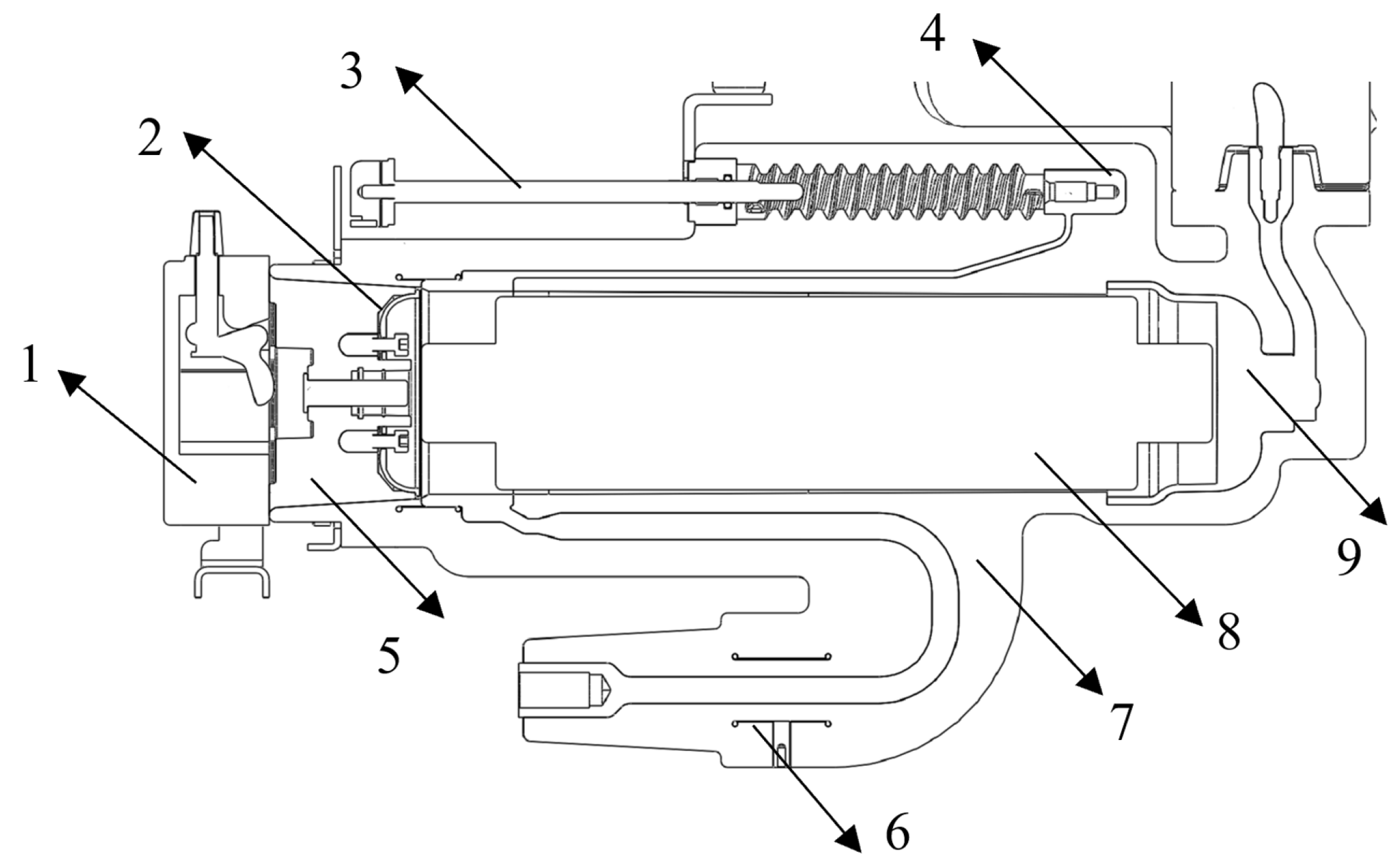


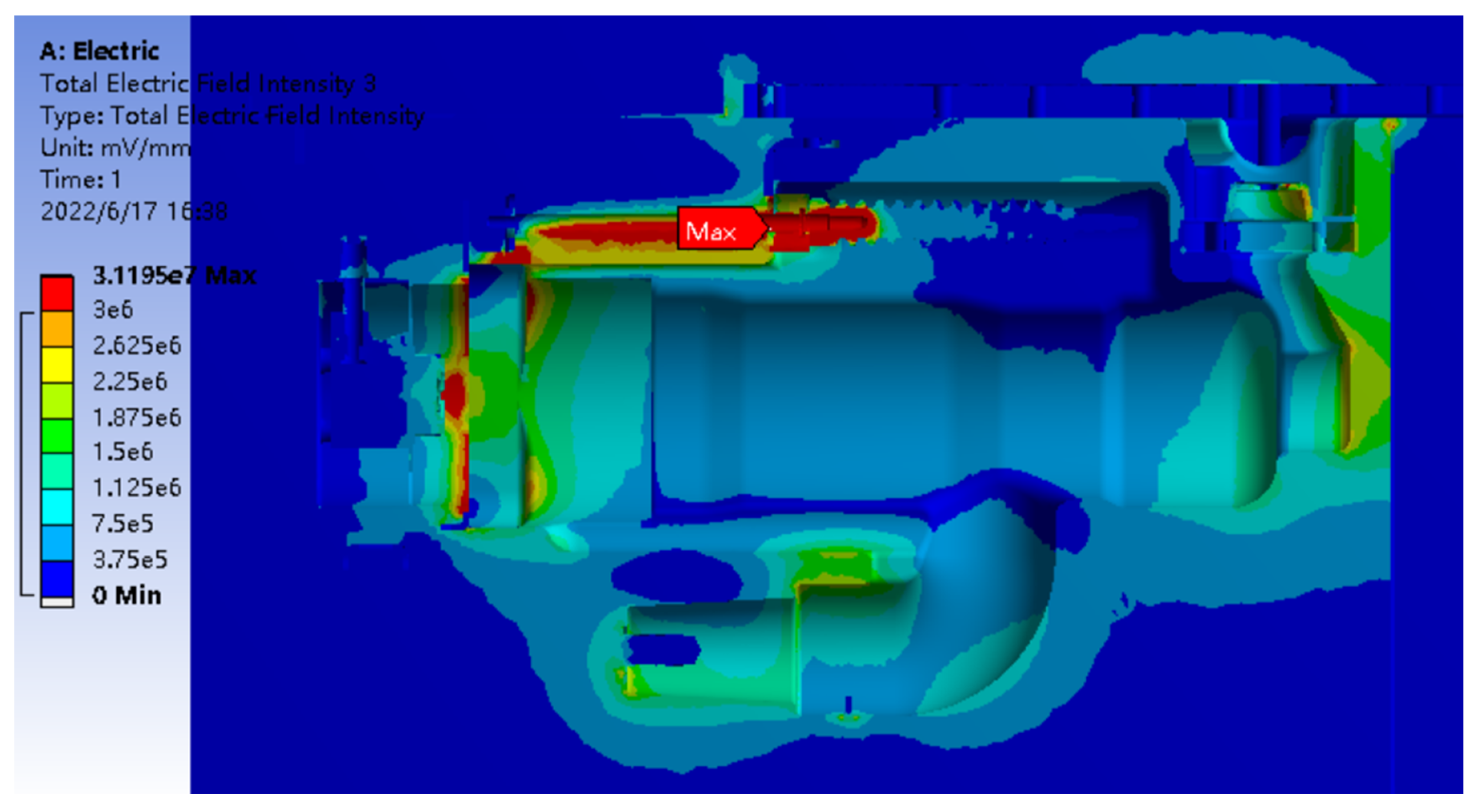
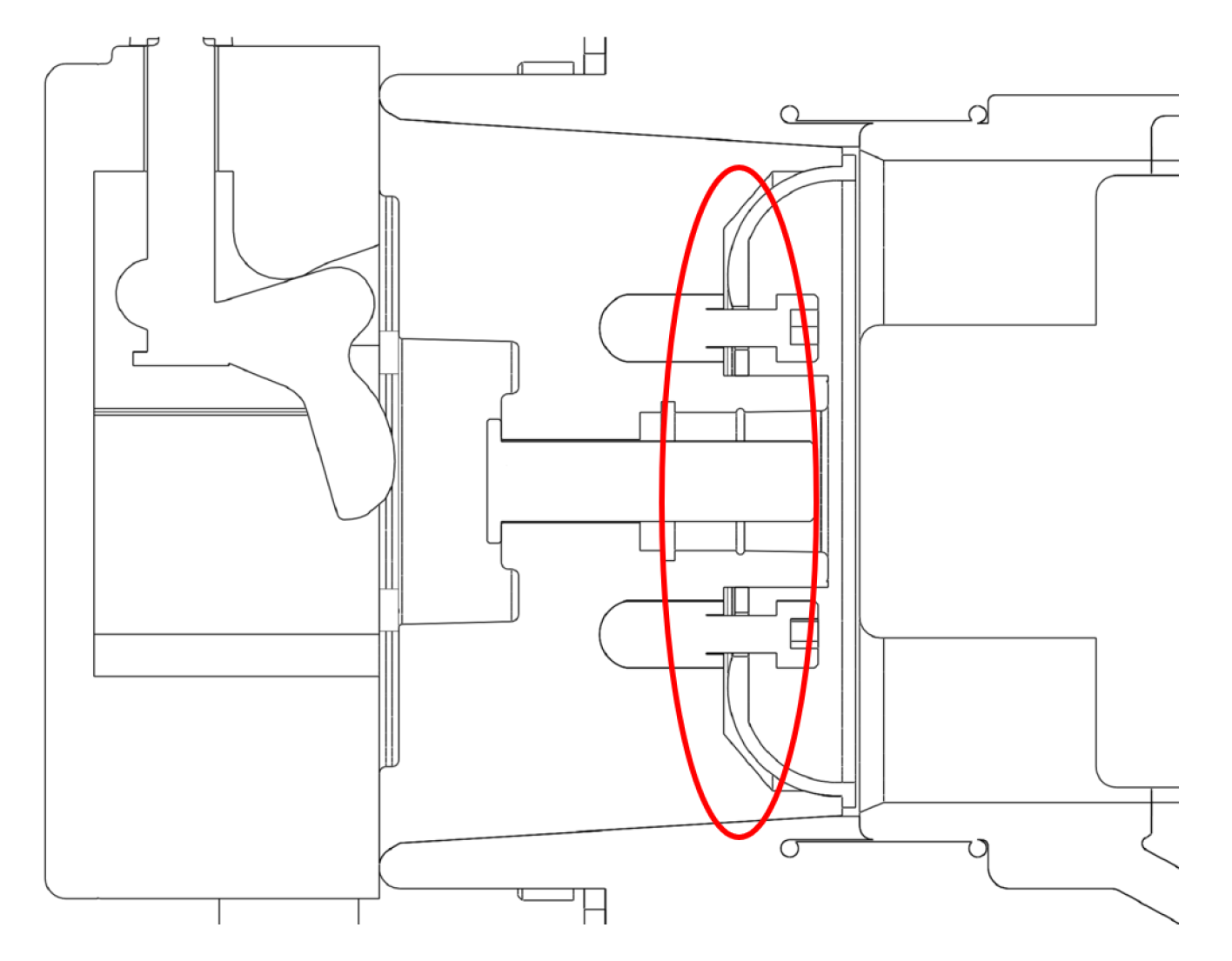
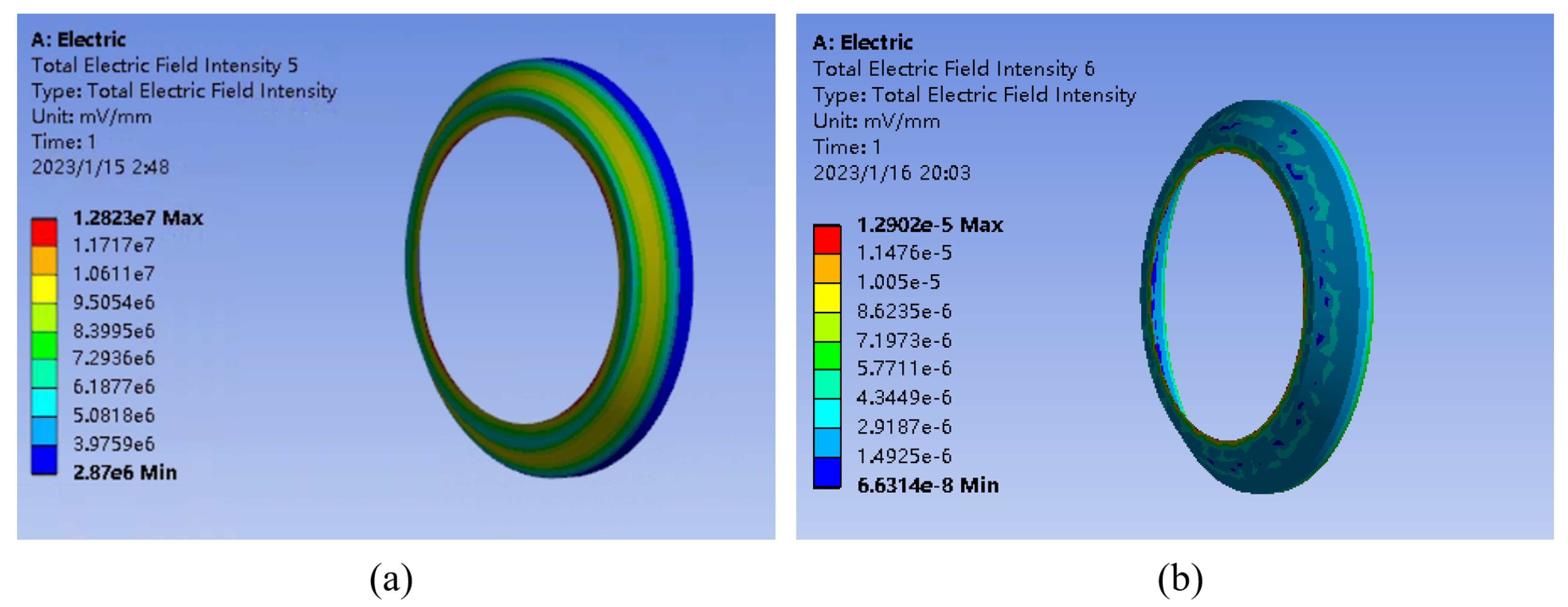


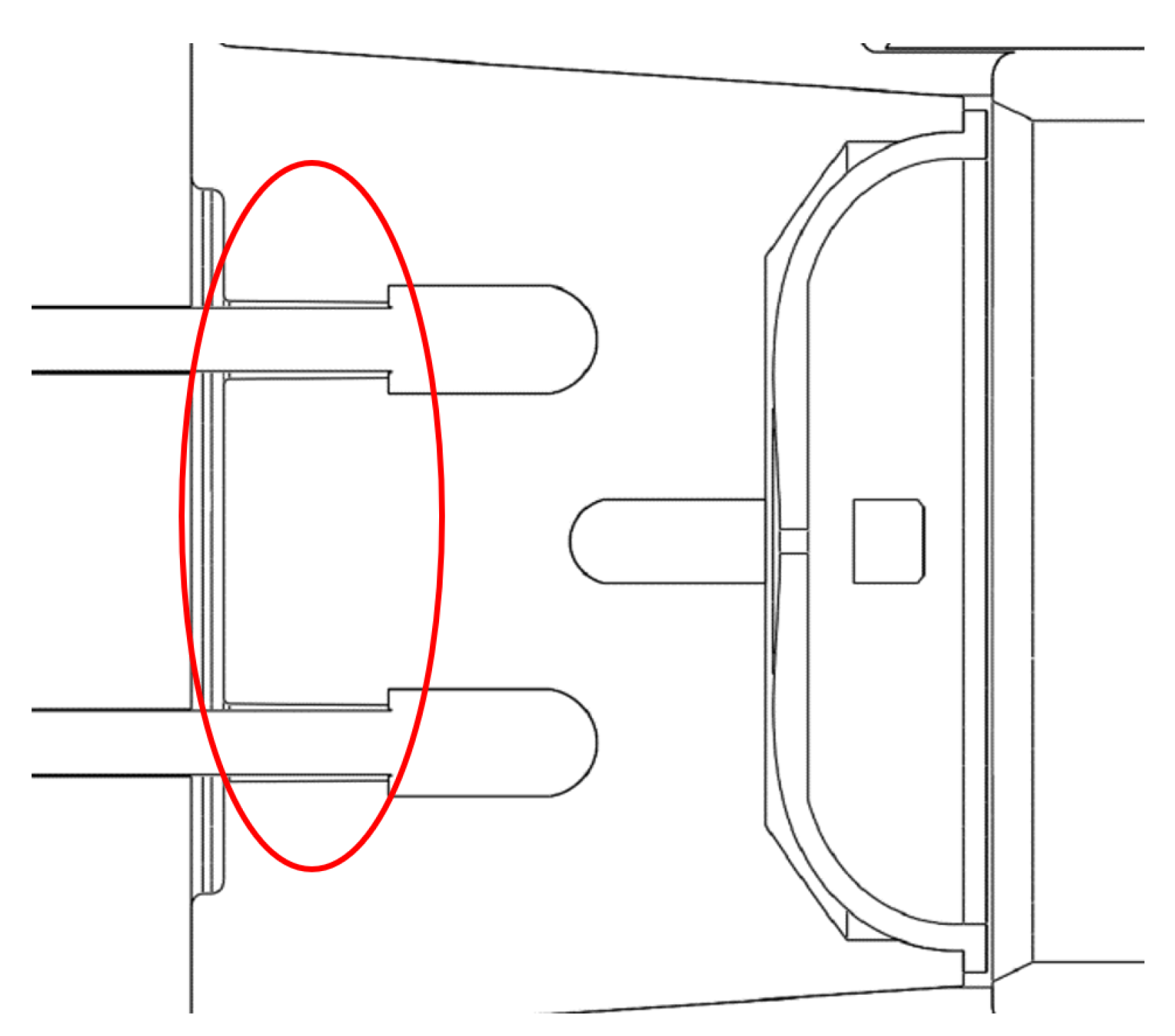

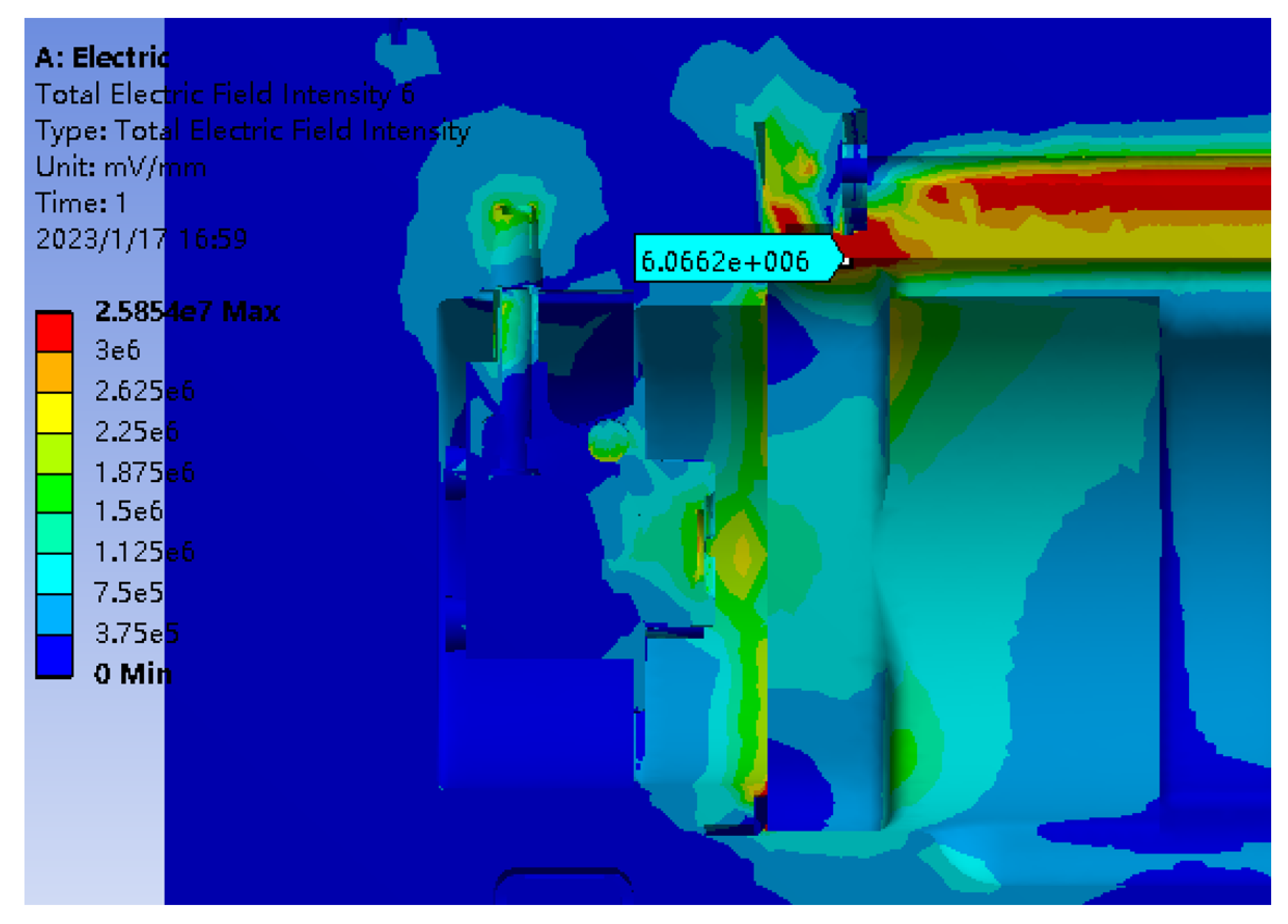
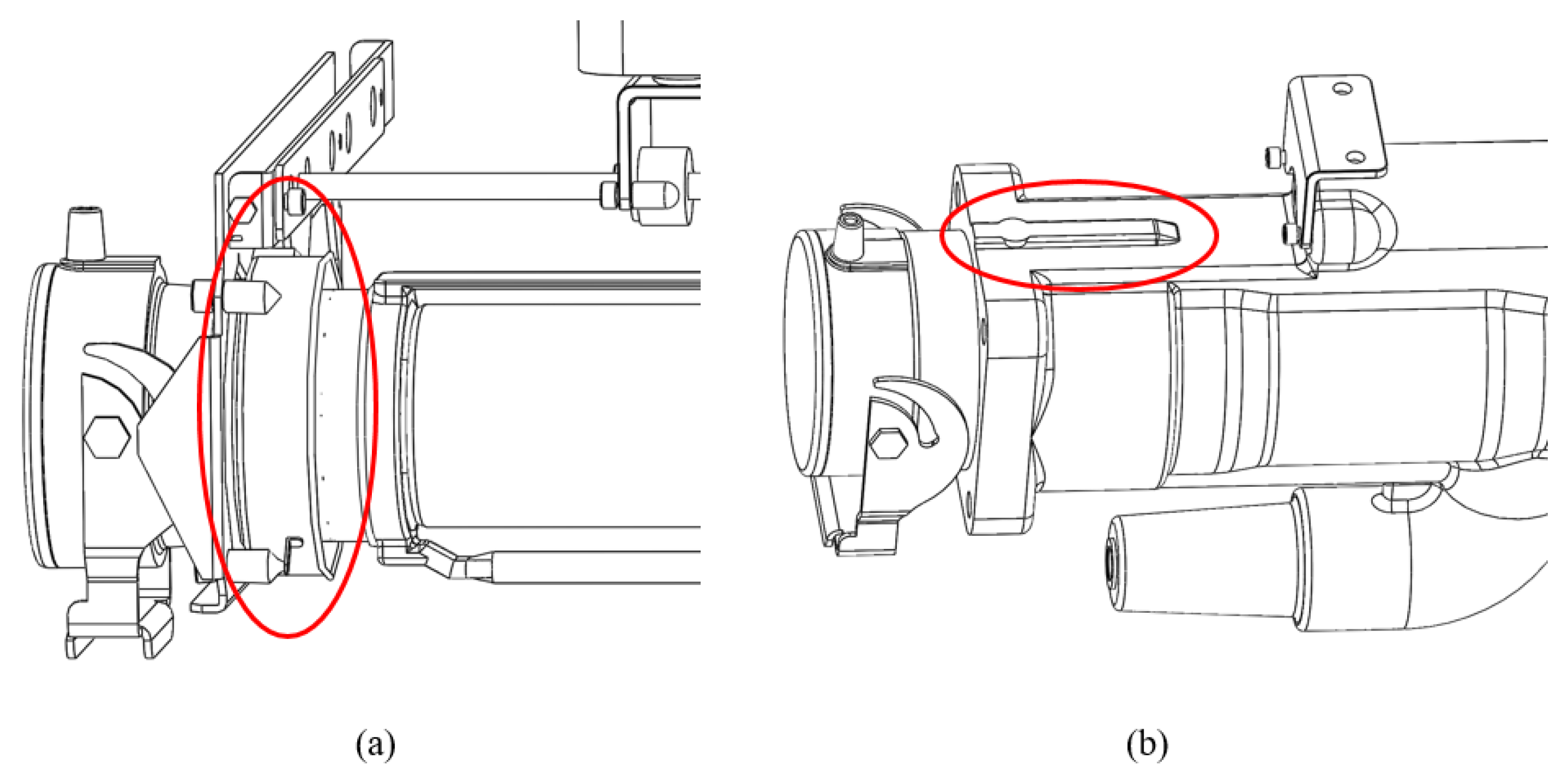
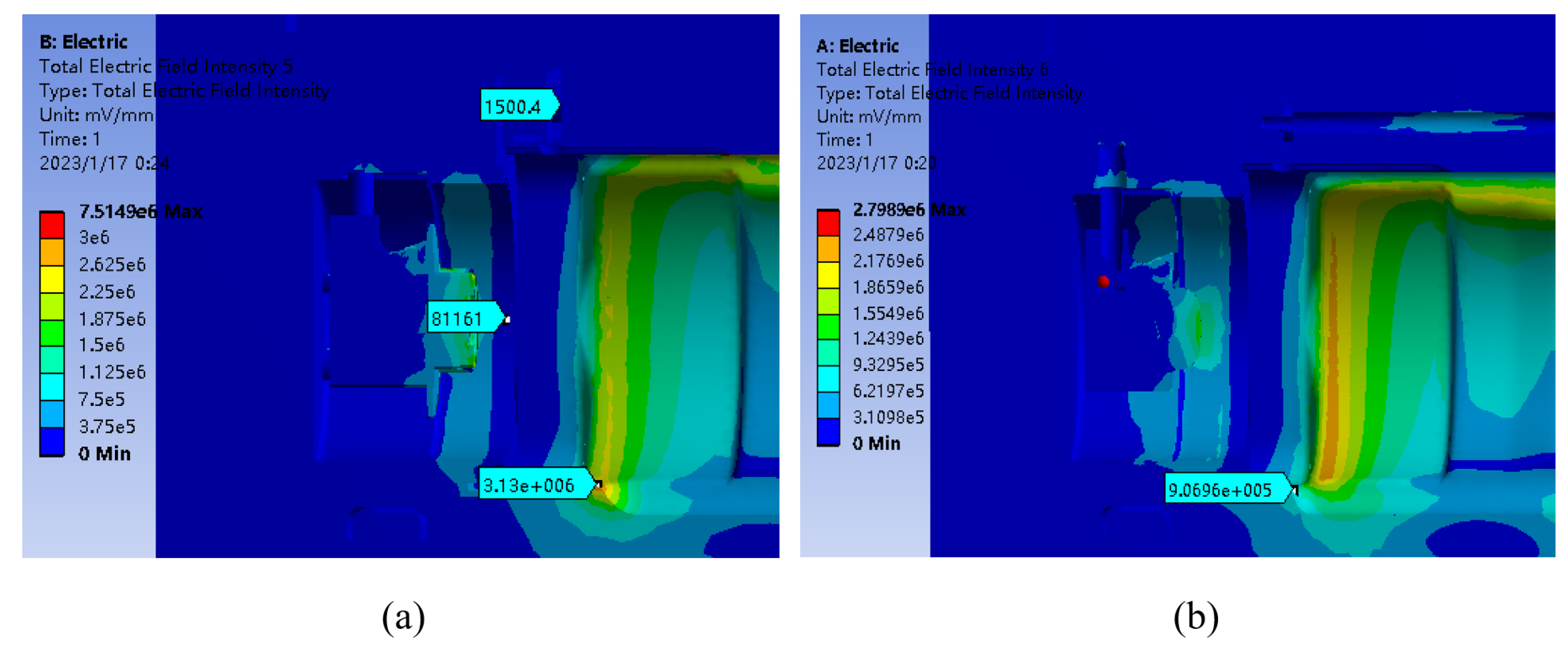
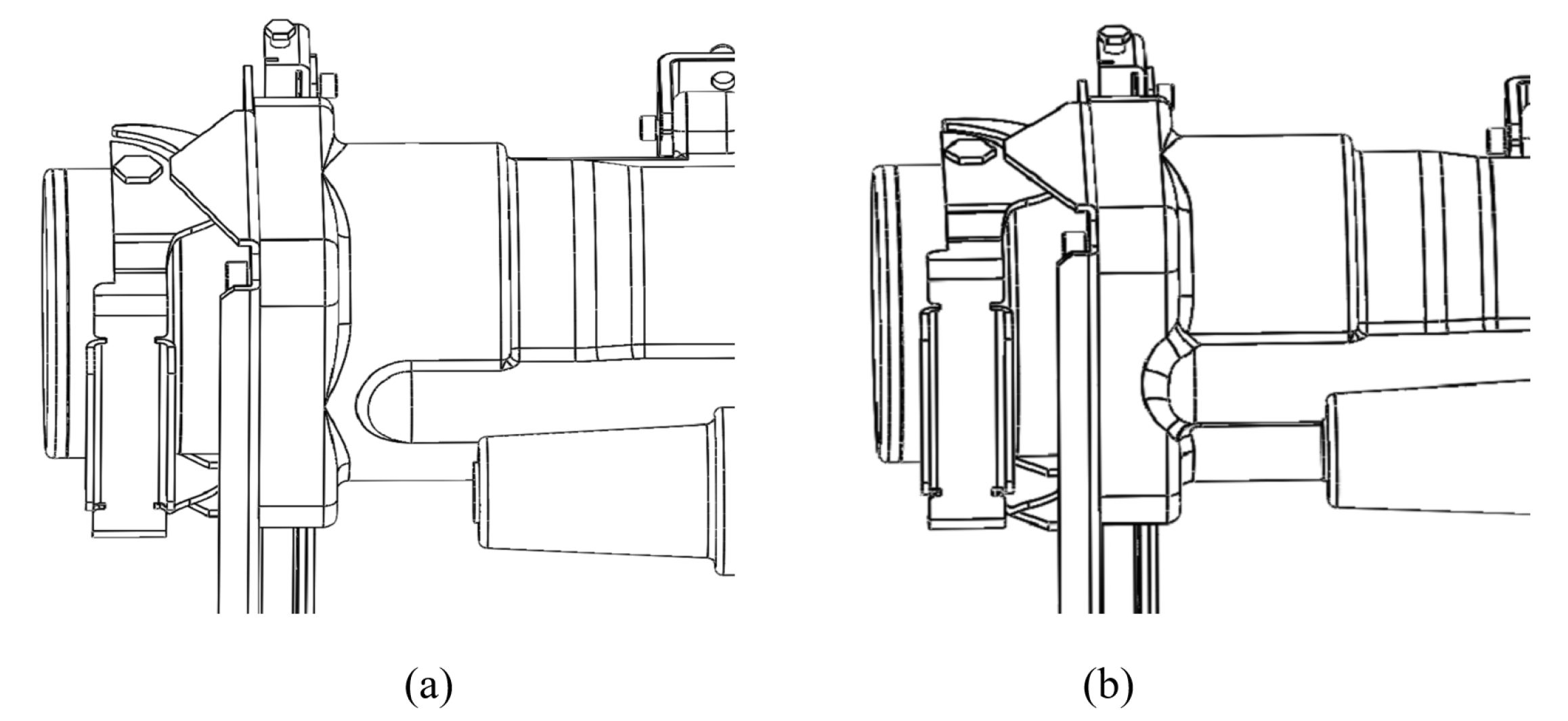

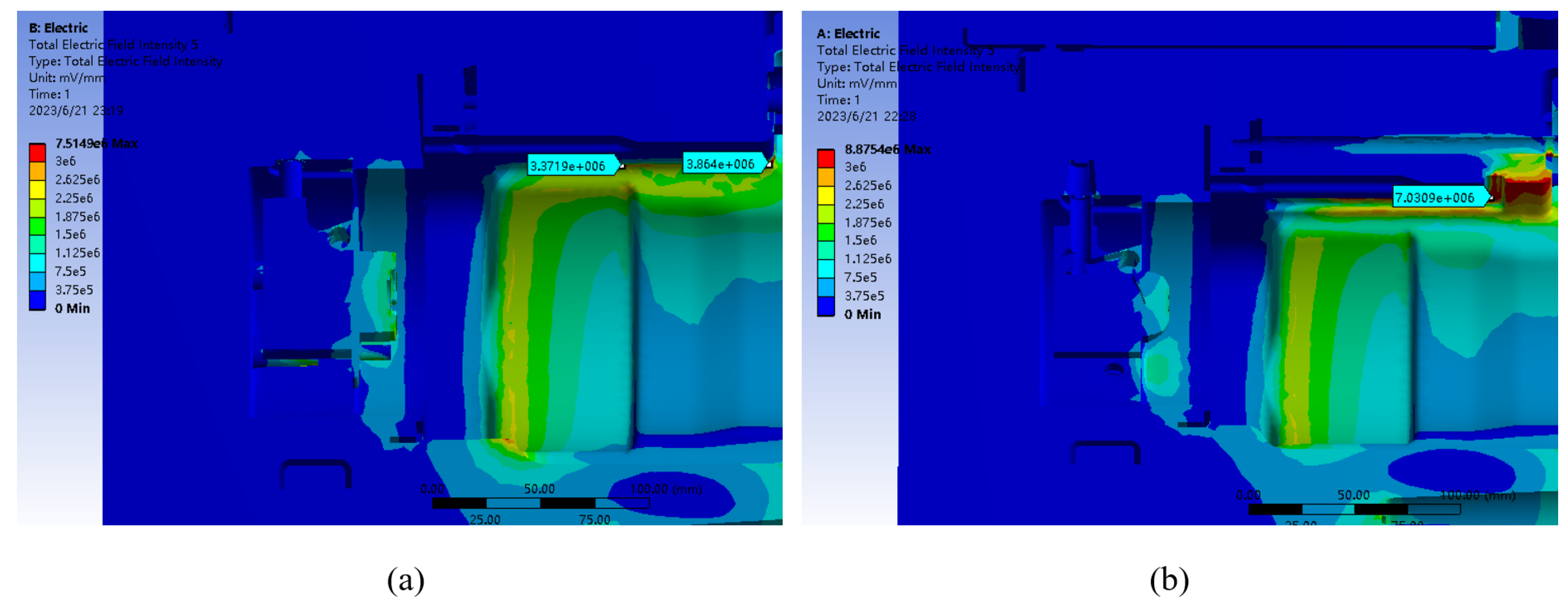



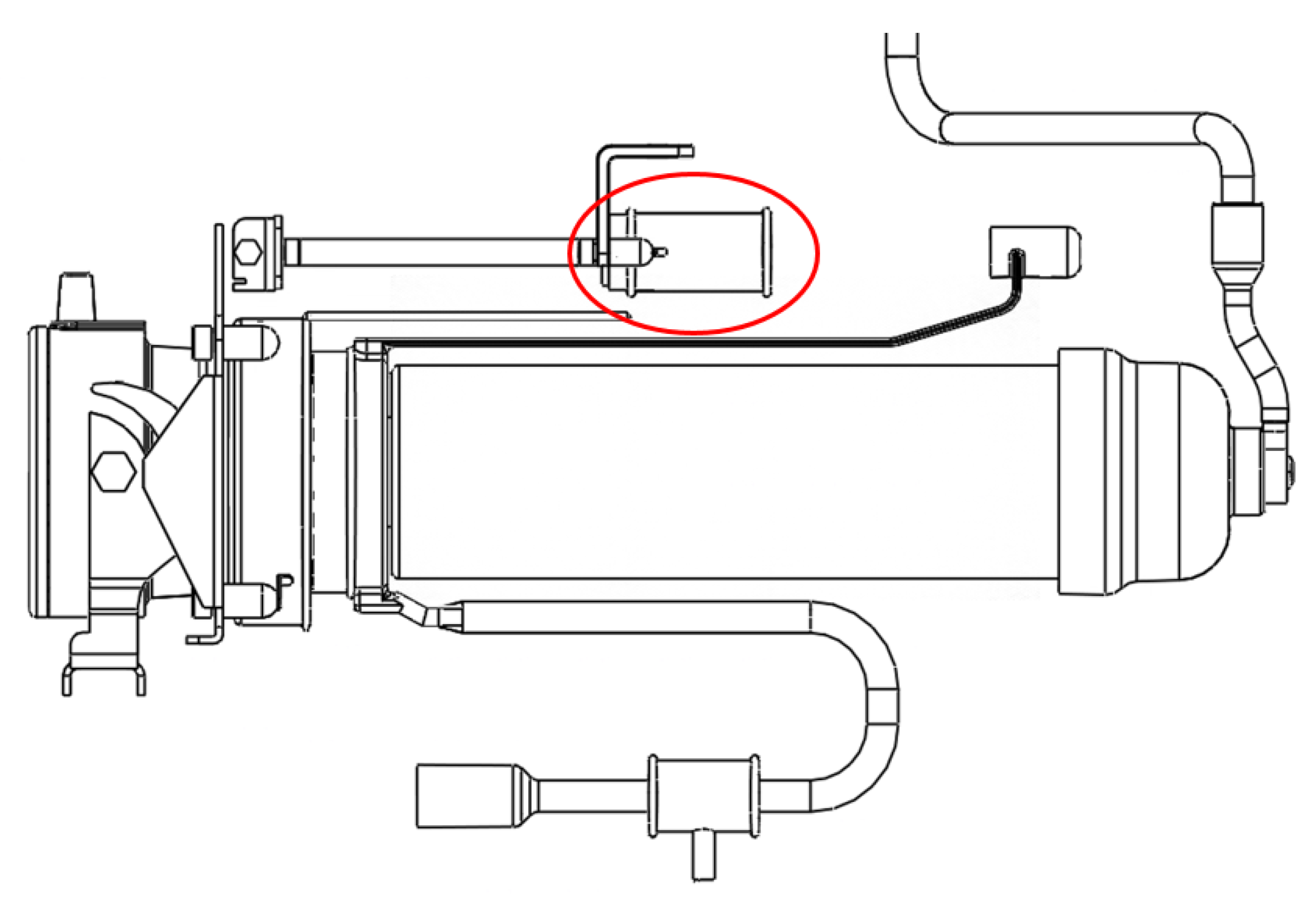




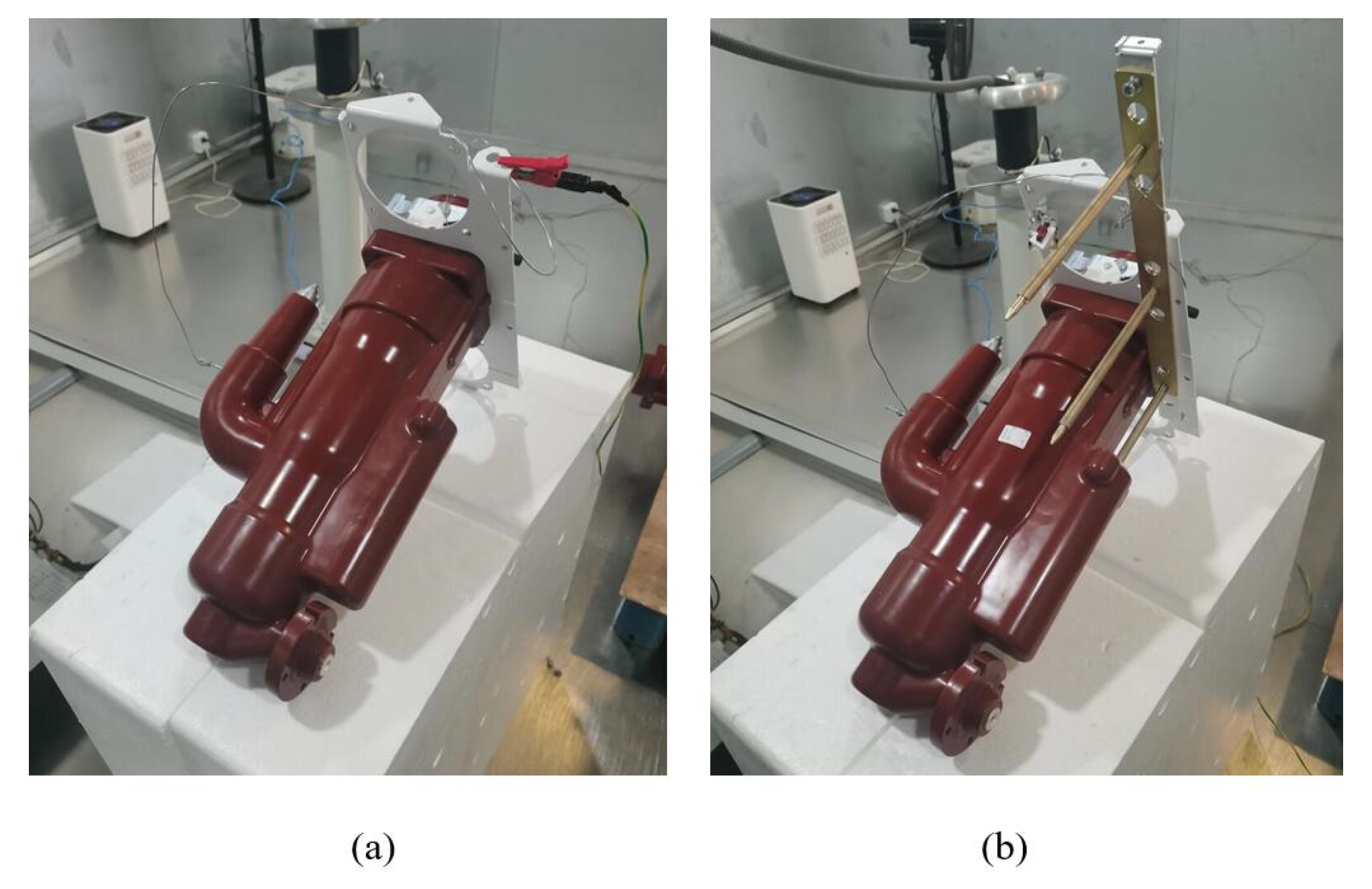


| Material | Relative Dielectric Constant | Average Breakdown Field Strength (kV/mm) |
|---|---|---|
| Air | 1.0 | 3.0 |
| Silicone rubber | 3.6 | 25.0 |
| Epoxy resin | 4.5 | 30.0 |
| Radius of the Ground Shielding Ring (mm) | Length of the Ground Shielding Ring (mm) | Maximum Field Strength (kV/mm) |
|---|---|---|
| 15.5 | 40.5 | 3.48 |
| 15.5 | 42.5 | 3.05 |
| 15.5 | 44.5 | 3.38 |
| 15.5 | 48.5 | 3.60 |
| 15.5 | 52.5 | 3.10 |
| 15.5 | 56.5 | 3.67 |
| 17.0 | 42.5 | 2.83 |
| Test Sample Number (mm) | Measured Discharge (pC) | Initial Discharge Voltage (kV) |
|---|---|---|
| A01 | 0.5 | 19.4 |
| A02 | 0.8 | 18.0 |
| A03 | 2.8 | 18.3 |
| B01 | 130 | 10.5 |
| B02 | 114 | 11.2 |
| B03 | 122 | 10.8 |
| C01 | 0.6 | 21.2 |
| C02 | 0.5 | 23.0 |
| C03 | 1.2 | 19.3 |
Disclaimer/Publisher’s Note: The statements, opinions and data contained in all publications are solely those of the individual author(s) and contributor(s) and not of MDPI and/or the editor(s). MDPI and/or the editor(s) disclaim responsibility for any injury to people or property resulting from any ideas, methods, instructions or products referred to in the content. |
© 2023 by the authors. Licensee MDPI, Basel, Switzerland. This article is an open access article distributed under the terms and conditions of the Creative Commons Attribution (CC BY) license (https://creativecommons.org/licenses/by/4.0/).
Share and Cite
You, Y.; Qiao, R.; Li, S.; Zhou, S.; Zhou, S.; Peng, Z. Improved Design of Fuse Tube for Environmental Protection Cabinet Based on Electric-Field Simulation. Energies 2023, 16, 5242. https://doi.org/10.3390/en16145242
You Y, Qiao R, Li S, Zhou S, Zhou S, Peng Z. Improved Design of Fuse Tube for Environmental Protection Cabinet Based on Electric-Field Simulation. Energies. 2023; 16(14):5242. https://doi.org/10.3390/en16145242
Chicago/Turabian StyleYou, Yimin, Rui Qiao, Shaojie Li, Shunxiong Zhou, Shenjun Zhou, and Zhenbo Peng. 2023. "Improved Design of Fuse Tube for Environmental Protection Cabinet Based on Electric-Field Simulation" Energies 16, no. 14: 5242. https://doi.org/10.3390/en16145242




